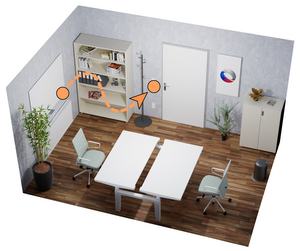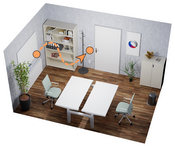Information
- Publication Type: Journal Paper with Conference Talk
- Workgroup(s)/Project(s):
- Date: May 2024
- Journal: ACM Transactions on Graphics
- Volume: 43
- Open Access: yes
- Number: 3
- Article Number: 35
- ISSN: 1557-7368
- Event: SIGGRAPH 2024
- DOI: 10.1145/3662180
- Pages: 16
- Publisher: ASSOC COMPUTING MACHINERY
- Keywords: differentiable rendering, global illumination, Lighting design, optimization, ray tracing
Abstract
Differentiable rendering methods promise the ability to optimize various parameters of three-dimensional (3D) scenes to achieve a desired result. However, lighting design has so far received little attention in this field. In this article, we introduce a method that enables continuous optimization of the arrangement of luminaires in a 3D scene via differentiable light tracing. Our experiments show two major issues when attempting to apply existing methods from differentiable path tracing to this problem: First, many rendering methods produce images, which restricts the ability of a designer to define lighting objectives to image space. Second, most previous methods are designed for scene geometry or material optimization and have not been extensively tested for the case of optimizing light sources. Currently available differentiable ray-tracing methods do not provide satisfactory performance, even on fairly basic test cases in our experience. In this article, we propose, to the best of our knowledge, a novel adjoint light tracing method that overcomes these challenges and enables gradient-based lighting design optimization in a view-independent (camera-free) way. Thus, we allow the user to paint illumination targets directly onto the 3D scene or use existing baked illumination data (e.g., light maps). Using modern ray-tracing hardware, we achieve interactive performance. We find light tracing advantageous over path tracing in this setting, as it naturally handles irregular geometry, resulting in less noise and improved optimization convergence. We compare our adjoint gradients to state-of-the-art image-based differentiable rendering methods. We also demonstrate that our gradient data works with various common optimization algorithms, providing good convergence behaviour. Qualitative comparisons with real-world scenes underline the practical applicability of our method.
Additional Files and Images
Additional images and videos
Additional files
Weblinks
BibTeX
@article{lipp-2024-val,
title = "View-Independent Adjoint Light Tracing for Lighting Design
Optimization",
author = "Lukas Lipp and David Hahn and Pierre Ecormier-Nocca and
Florian Rist and Michael Wimmer",
year = "2024",
abstract = "Differentiable rendering methods promise the ability to
optimize various parameters of three-dimensional (3D) scenes
to achieve a desired result. However, lighting design has so
far received little attention in this field. In this
article, we introduce a method that enables continuous
optimization of the arrangement of luminaires in a 3D scene
via differentiable light tracing. Our experiments show two
major issues when attempting to apply existing methods from
differentiable path tracing to this problem: First, many
rendering methods produce images, which restricts the
ability of a designer to define lighting objectives to image
space. Second, most previous methods are designed for scene
geometry or material optimization and have not been
extensively tested for the case of optimizing light sources.
Currently available differentiable ray-tracing methods do
not provide satisfactory performance, even on fairly basic
test cases in our experience. In this article, we propose,
to the best of our knowledge, a novel adjoint light tracing
method that overcomes these challenges and enables
gradient-based lighting design optimization in a
view-independent (camera-free) way. Thus, we allow the user
to paint illumination targets directly onto the 3D scene or
use existing baked illumination data (e.g., light maps).
Using modern ray-tracing hardware, we achieve interactive
performance. We find light tracing advantageous over path
tracing in this setting, as it naturally handles irregular
geometry, resulting in less noise and improved optimization
convergence. We compare our adjoint gradients to
state-of-the-art image-based differentiable rendering
methods. We also demonstrate that our gradient data works
with various common optimization algorithms, providing good
convergence behaviour. Qualitative comparisons with
real-world scenes underline the practical applicability of
our method.",
month = may,
journal = "ACM Transactions on Graphics",
volume = "43",
number = "3",
articleno = "35",
issn = "1557-7368",
doi = "10.1145/3662180",
pages = "16",
publisher = "ASSOC COMPUTING MACHINERY",
keywords = "differentiable rendering, global illumination, Lighting
design, optimization, ray tracing",
URL = "https://www.cg.tuwien.ac.at/research/publications/2024/lipp-2024-val/",
}


